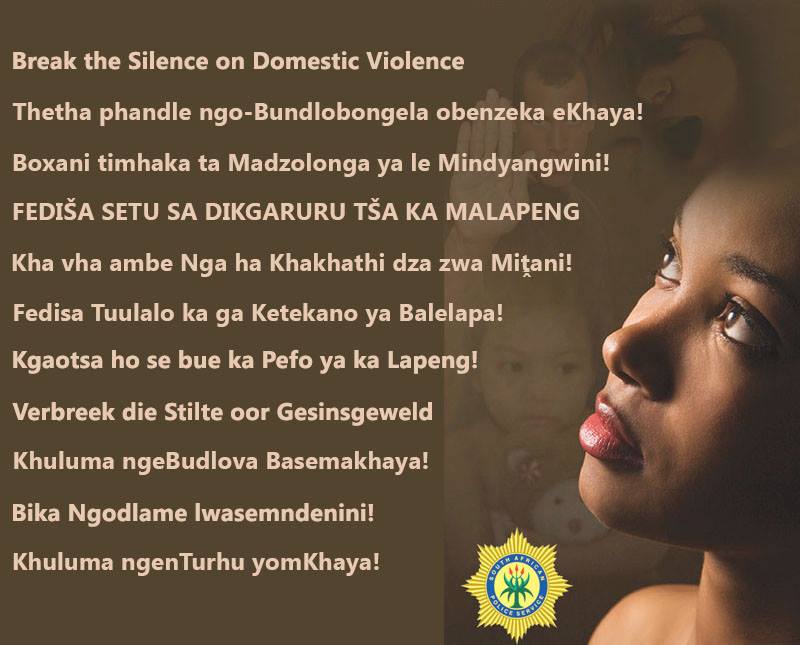Many South Africans still regard domestic violence as a private matter, but this is a criminal offence that is punishable by law. Through various Departments, Government has introduced legislation to reduce domestic violence.
What is domestic violence?
According to the Domestic Violence Act, 1998 (Act No 116 of 1998) it is –
- any form of abuse which includes physical, sexual, emotional, psychological or economic harassment
- damage to property
- stalking
- entry into a person’s home without their consent
- any other abusive or controlling behaviour where such conduct causes harm or may cause harm to your health, safety, or well-being.
Support for victims of abuse
There are various, specialised, victim-support services and one-stop centres:
-
- Thuthuzela Care Centres: These centres are mainly based at health facilities and aim to reduce secondary victimisation, improve conviction rates and reduce the cycle time for conclusion of cases.
- Khuseleka One-Stop Centres: These centres provide services for female and child victims of violence, such as trauma counselling and psychosocial support, health care, police services, legal assistance and shelter services. The centres are open 24 hours.
- SAPS Family Violence, Child Protection and Sexual Offences Units (FCS). The FCS Units fight against sexual offences against children, person-directed crimes (where the family is involved), illegal removal of children under the age of 12 and crime facilitated through the electronic media.
For help, call SAPS Crime Stop: 08600 10111 or the Department of Social Development Command Centre: 0800 428 428.
If you are abused, you have the right to apply for a protection order at the nearest police station or Magistrate’s Court. You may lay a criminal charge at the police station and apply for a protection order. A domestic violence protection order is a document that the court issues and it protects the victim from the abuser.
How does one obtain a protection order in terms of the Domestic Violence Act, 1998 (Act No 116 of 1998)?
Who can apply for a protection order?
- Any person who has been in a domestic relationship with the respondent.
- When is there a domestic relationship between the complainant and the respondent?
- If they are or were married to one another; if they live or lived together in a relationship in the nature of a marriage, though they are/were not; if they share parental responsibility over a child; if they are/were engaged, dating or in a customary relationship; if they are blood relatives or related by affinity or adoption; if they share or recently shared the same residence.
Against whom can a protection order be obtained?
- Any person who is or has been in a domestic relationship with a complainant and who has committed or allegedly committed an act of domestic violence against the complainant.
- Who has the duty to inform the complainant of their rights in terms of the DVA?
- A member of the South African Police Service (section 2) Form 1 of Regulation 2; Notice to complainant in a case of domestic violence.
Where can a complainant apply for a protection order?
- At any Magistrates Court or Family Court established in terms of an Act of Parliament (section 4(1) read with section 1 (section 12).
- Any court in the area where the complainant permanently resides, carries on business or is employed.
- In the area where the respondent resides, carries on business or is employed or any court in the area where the abuse took place or is taking place.
Can a complainant be represented by a lawyer when applying for a protection order?
Yes – section 14.
With whom must the application for a protection order be lodged at the Magistrate’s Court?
The Clerk of the Court – section 4(7).
Can a minor apply for a protection order without the assistance of a guardian?
Yes – section 4(4).
When is it allowed for an application for a protection order to be brought outside ordinary court hours or on a day that is not an ordinary court day? If the court is satisfied that the complainant will suffer undue hardship if the application is not dealt with immediately – section 4(5).
What documents must the complainant submit when applying for a protection order?
An application substantially corresponding to Form 2 of Regulation 4 of the DVA regulations; application for a protection order.
Supporting affidavits by persons who have knowledge of the matter – sections 4(6) and (7).
What happens if the court does not issue the interim protection order?
Section 5(4) – the court must direct the clerk of the court to cause certified copies of the application and any supporting affidavits to be served on the respondent in the prescribed manner, with the prescribed notice (Form 5 of Regulation 7); calling on the respondent to show cause why a protection order should not be issued.
Issuing of final protection order
Section 6(1) – A final protection order will be issued if the respondent does not appear on the return date as set out in the interim protection order, or if the respondent does not appear on the return date as set out in the notice when an interim protection order was not granted. Section 6(2) – if the respondent appears on the return date as set out in the interim protection order or notice and opposes the issuing of a protection order, the court will then proceed to hear the matter. A protection order issued by the court must be in the prescribed form either in accordance with Form 6 of Regulation 8, or Form 7 of Regulation 8.
What happens after a protection order has been issued?
Section 6(6) – the clerk of the court must send certified copies of the protection order and warrant of arrest to the police station of the complainant’s choice.
Issuing of the warrant of arrest
Section 8(1)(a) – the warrant of arrest must be authorised and issued in accordance with Form 8 of Regulation 9. Whenever a court issues a protection order, the court must make an order authorising the issue of a warrant of arrest. The execution of the warrant of arrest is suspended subject to compliance with any prohibition, condition, obligation or order imposed by the court.
Information provided by Government Communications.



























